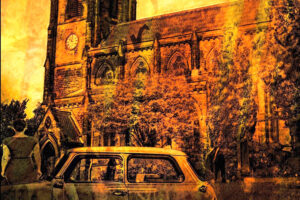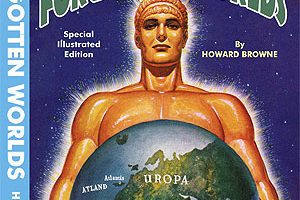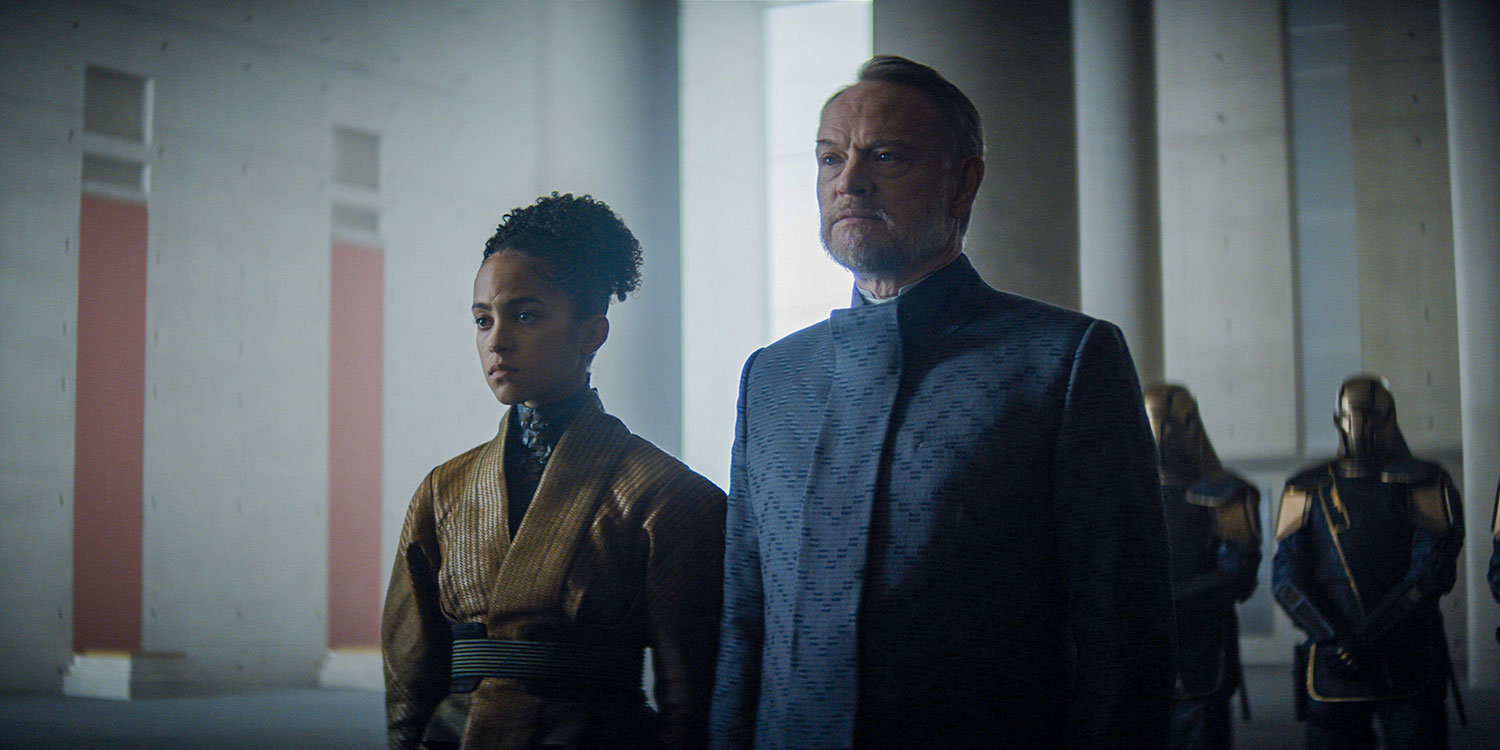
As a new TV series on Apple TV+ based on Isaac Asimov‘s Foundation series has started, I am overdue posting on him and his overall “future history” works that are his Robot, Empire, and Foundation series.
While I have read most of these works, it was years ago and some things I don’t recall. I also debated if I should cover them in the order of how I read them, or when they are set in this future history. I’m going for a mix. Some of the things I’ve read recommend reading them more along the lines of when they were written than their placement in the series.
I have also posted on his Black Widowers series of mysteries, so check that out as well.
I first read the Foundation trilogy back in the late 1970s in high school. I got the boxed set of the three novels for Christmas, with the strange covers by Don Punchatz. I also recall thinking early on that Second Foundation had to be the second one, before I realized it was the third. Later on in the late ’80s, new editions of the Robot and Empire novels came out and I read them, along with some of the new works that tied the three together.
While I got the sequel Foundation novels, I actually didn’t get into the Foundation prequel novels that came out a little later. I do recall elements of these works, but there were some matters I don’t recall being answered. Maybe I missed it, or maybe it was answered someplace I didn’t read.
Isaac Asimov (1920-92) is considered one of the grand masters of “hard sf,” along with Robert A. Heinlein and Arthur C. Clark. I’ve posted on Heinlein. Clark is probably best known for 2001: A Space Odyssey, Rendezvous With Rama, and Childhood’s End. Asimov, like all science-fiction authors who wrote before 1950, began as a pulp sf author. That was pretty much the only market for such fiction. Thus his early sf appeared in the pulp sf magazines like Amazing Stories and Astounding Tales.
What is sometimes forgotten about him is that he earned a Ph.D. in biochemistry and was a college professor for decades. So, writing science fiction was not the main part of his life. And in addition to his science fiction, he wrote quite a bit of non-fiction as well, including works on popular science. He did a long-running series of articles for Fantasy and Science Fiction that ran nearly 400. These were then collected in books, but I’m not certain if all were. I have most of them, though maybe not all of them.
The Robot series
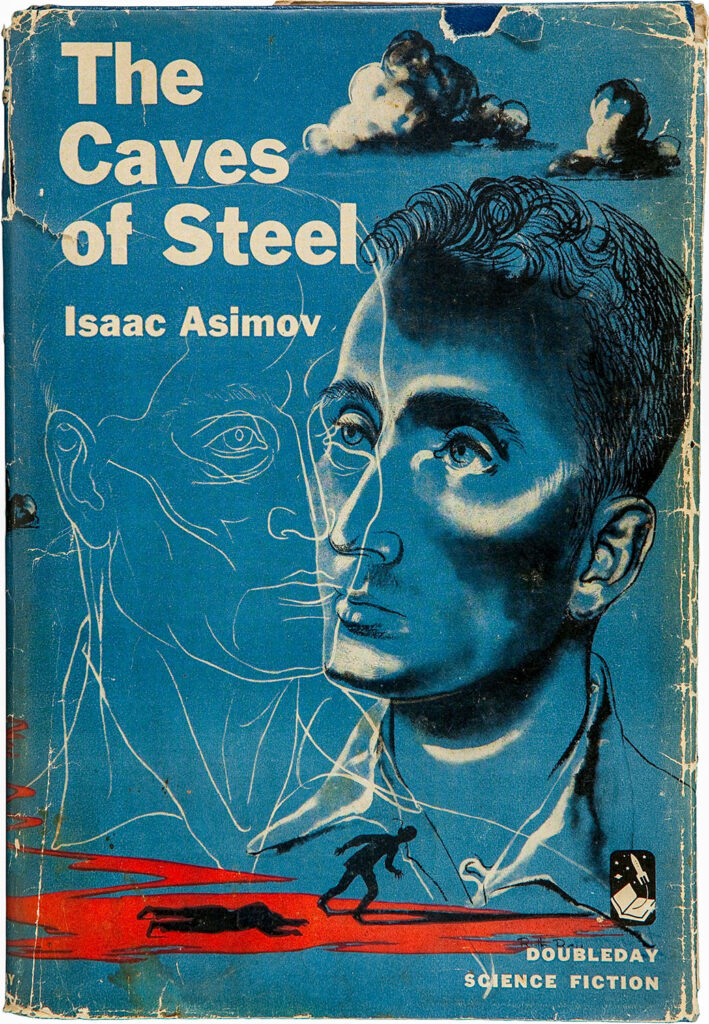 Chronology-wise, we start off with the Robot stories. These appeared first as short stories, most well-known being “I, Robot,” turned into a 2004 movie starring Will Smith that has little to do with the original story. Big surprise! It’s where we learn of the Three Laws of Robotics, and how robots have positronic brains. These short stories were collected into books like The Complete Robot (1982). To be honest, I never read it.
Chronology-wise, we start off with the Robot stories. These appeared first as short stories, most well-known being “I, Robot,” turned into a 2004 movie starring Will Smith that has little to do with the original story. Big surprise! It’s where we learn of the Three Laws of Robotics, and how robots have positronic brains. These short stories were collected into books like The Complete Robot (1982). To be honest, I never read it.
What I read in the 1980s were the four Robot novels starring R. Daneel Olivaw and human detective Elijah Baley, which were actually sf detective stories:
- The Caves of Steel (1954; Galaxy 1953)
- The Naked Sun (1957; Astounding SF, 1956)
- The Robots of Dawn (1983)
- Robots and Empire (1985)
As you can see by the dates, the first two were written back in the ’50s, first serialized in magazines. The last two were written later, and Asimov was linking the Robot series to the Empire novels. All have R. Daneel Olivaw, who is a robot. That’s what the “R” before his name stands for. He is a self-aware “humanform” robot. I guess most would call him an android, as he looks exactly like a human. He can even eat, which was important in the first book. Elijah Baley is human, a detective living on Earth.
These novels are set about 2,000 years after present. We learn that humanity is divided in two main groups. Most of humanity is crammed on the Earth. Robots are used for hard, physical labor, but are otherwise absent from society by this time. In fact, most Earthers are prejudiced against robots. The rest of humanity are known as “Spacers”. They live in luxury alongside robots on 50 worlds that are more garden worlds with low populations. In some cases, there are more robots than humans.
At some point, humanity will escape Earth and start colonizing the galaxy, overtaking the Spacers, whose culture will disappear. In fact, they and their worlds will be forgotten, which always puzzled me. Robots will also disappear; in this second human diaspora, robots will not be part of it. But I’m getting ahead of myself.
These four novels are mystery tales. In Caves, a faction of Spacers is trying to encourage humanity to colonize with robots, but most Earthers hate robots. So the Spacers setup a station on Earth to help overcome this. The main Spacer is murdered, and Baley is assigned to solve it, assisted by Olivaw.
In Naked Sun, a murder happens on one of the Spacer worlds, which is rare. Baley is asked to come solve it, again with Olivaw to help. This gives us a view of one of the Spacer worlds.
Robots of Dawn again takes Baley to a Spacer world to solve a crime, this time the destruction of a human-form robot. We again learn of factions among the Spacers: some who wish to help Earth, others do not.
Finally, Robots and Empire is set 200 after the others. Humans from Earth are now settling the galaxy, calling themselves “Settlers”. And we have another mystery, though without Elijah Baley, we have a descendant of his working with Olivaw. We also see the creation of a “Zeroth” Law of Robotics, and understand why the later Galactic Empire knowns nothing of Earth or where it is.
The Empire series
 Moving on to the Galactic Empire novels, by internal chronology they are:
Moving on to the Galactic Empire novels, by internal chronology they are:
- The Stars, Like Dust (1951)
- The Currents of Space (1952)
- Pebble in the Sky (1950)
These are all set hundreds (maybe thousands?) of years after the Robot stories. As noted, robots do not exist, so we are seeing the emergence of what will be the Galactic Empire of the Foundation series.
The Stars tells of a young man dealing with a tyrannical ruler in his part of the galaxy, and trying to overcome this and survive. Currents has a story of political intrigue and conquest between two planets set in the background of Trantor, a planet at the center of the galaxy that is building an empire, so far covering half the galaxy! The young man at the center of this story learns that he is from Earth, a planet now radioactive, which is rumored to be the birthplace of humanity. But few believe that.
Pebble in the Sky is notable for being Asimov’s first novel! It is set on Earth, now part of the Trantor Empire. Earth is viewed by the rest of the galaxy as unimportant, and looked down upon. Earthers are resentful. The planet is suffering from radioactivity. And a radical element is creating a virus to strike down the rest of the galaxy. Can they be stopped? Can Earth be restored?
The Foundation series
Now we move to the Foundation series, what was for many years just the Foundation trilogy. The original series of short stories were linked together into the novels of the trilogy. Set tens of thousands of years in the future, we have a galactic empire that actually covers the whole galaxy. Earth is but a distant memory. Robots, as I noted, do not exist. But the empire is doomed. The capitol of the empire is the world Trantor, which is in the center of the galaxy. But the empire is becoming harder and harder to govern, and like the Roman Empire, the Galactic Empire will likely collapse, but few foresee that.
A scientist named Hari Seldon has developed a new mathematical science, “psychohistory,” that can predict the future, sort of. It can actually only work when you use large numbers of people — the larger the better — and understand how they will act in the future. He has worked out that the empire will soon collapse. Nothing will stop it. After it collapses, there will be a long dark age before civilization can rebuild, some 30,000 years.
But he has a plan that will shorten that dark age and speed up the rebuilding to just a 1,000 years. His plan is to have a group of scientists and researchers be placed on a distant world of the empire: Terminus. There they will create a repository of knowledge: a Galactic Encyclopedia. This Encyclopedia Foundation will help in shortening that dark age.
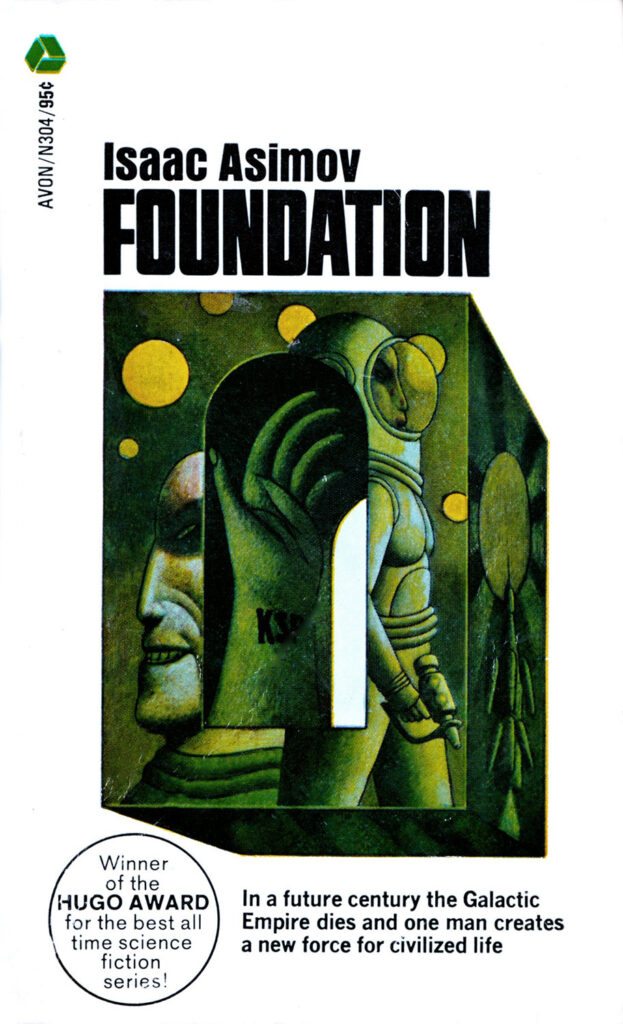 I guess I should point out for modern readers to keep in mind that these were written in the 1950s. The idea of personal computers, much less the idea of the internet (galacticnet?) did not exist. So this Encyclopedia would be a published series of books compiled by people. There is no Wikipedia or the like in existence.
I guess I should point out for modern readers to keep in mind that these were written in the 1950s. The idea of personal computers, much less the idea of the internet (galacticnet?) did not exist. So this Encyclopedia would be a published series of books compiled by people. There is no Wikipedia or the like in existence.
And so started off the original Trilogy of:
- Foundation (1951)
- Foundation and Empire (1952)
- Second Foundation (1953)
Seldon lived just long enough to see the establishment of the Foundation, but he did create a series of recordings that would play at certain times. We soon would learn there was much more to the Foundation than was thought. Basically, the encyclopedia was not its main purpose. Its main purpose was to create the next galactic empire, and at certain points that Seldon knew were arise, “Seldon crisises”, he had a recording to help out. Over time, the Foundation grew, helped by new inventions developed by the scientists and engineers gathered for the work of the Foundation. Basically the Foundation was to be the foundation of the next empire! Also, the first book, made up of a series of short stories, is very episodic, with each one set years after the prior (over 150 years total), with often new groups of characters.
In the second book, some 100 years after the Foundation went up against the remains of the Empire, a new threat arose that Seldon didn’t foresee: The Mule. And the Foundation learns that Seldon had created a Second Foundation to protect the plan. The Mule is a mutant who can control emotions He throws off Seldon’s plan, but also tries to find and destroy the Second Foundation, but fails.
In the third book, the Mule is still looking for the Second Foundation. We discover that the First Foundation had focused on physical sciences, while the Second had advanced Seldon’s psychohistory, as well as the mental sciences. With this, they defeat the Mule, who returns to his little empire without any further thought of them. But the Foundation now sees the Second Foundation as a rival that must be destroyed. Thus, they think they have found and destroyed the Second, but it was just a decoy, but it had the desired effect: Seldon’s plan is back on track. There is a whole thread on where the Second Foundation is located that you’ll need to read and discover for yourself.
Much later, Asimov wrote the prequel works:
- Prelude to Foundation (1988)
- Forward the Foundation (1993)
These I never read, but know they cover Seldon’s earlier life and his creation and development of psychohistory. As I noted, some things I’ve read have suggested it’s best not to read these before the original Foundation trilogy, and maybe not after the sequels.
He also wrote sequels to the trilogy that tied back in the Robot series:
- Foundation’s Edge (1982)
- Foundation and Earth (1986)
These I have read. In them, we learn what happened to Earth, the Spacer worlds, what happened to robots to a degree, and especially Olivaw and his connection to the Foundation. He is now 20,000 years old. We also have a visit to the now long-abandoned Spacer worlds, which always puzzled me that such worlds had been overlooked in all of this. Why would not someone had explored, found them, and re-colonized them?
I found the original trilogy quite interesting. While the original Empire and Robot novels are great, I have mixed feelings of the attempt to tie everything together.
The Foundation TV series
I also have mixed feeling about this TV series. If you haven’t seen the series, you might not want to read the rest, as I may give stuff away. While I haven’t seen the series, I read of it and watched several videos about it. Two things really bother me. The first is the addition of stuff, characters and themes, that are just NOT in the original books. The whole cloning of the Emperor with Brothers Dawn, Day, and Dusk is NOT part of the original. Part of this seems to show that the Emperor and the Empire are, frankly, evil to a large degree and so you almost WANT them to fall. But that was never the point of the original. The Empire fell because of bureaucracy. They couldn’t sustain themselves.
And more concerning to me is where they have ALTERED what was in the original. There is mention of a “Robot War” to explain why there are no robots, but there was NO SUCH EVENT in the original books. And we have a robot working for the Emperor, who should not exist! They have Hari be murdered. Nope, didn’t happen. They make the Vault something it wasn’t in the original. It was NOT his tomb, but a vault with recordings Hari made that would be played at certain points to when a crisis occurs. There is also a point where Terminus is invaded by 2 warring factions. Again, never happened. The Foundation had, due to limited resources, had to come up with new and better technology, which enabled them to fight off any possible invaders and in fact expand their control. So they don’t need some unknown Empire-built superweapon. And we are told the purpose of the Foundation in the first series, but this happens 50 years after it was established, so they shouldn’t be living in primitive conditions, and the existence of the Second Foundation wasn’t revealed until MUCH later. The first season time-wise has to have occurred no more then midway thru the FIRST book.
Am sure there are articles and videos out there pointing out the differences between the books and the show. But these alterations really are a turn off for me. I can understand the need to add stuff to make the series into a tv series, but to change fundamental elements I don’t care for.
Instead check out the original works and decide for yourself which you like better.


